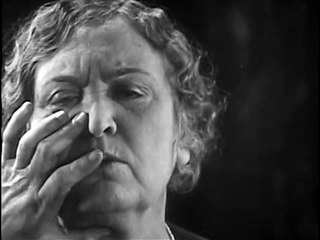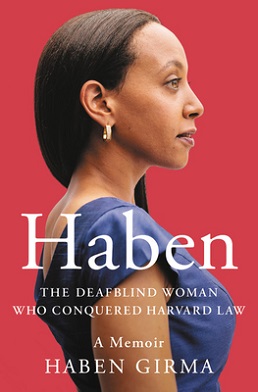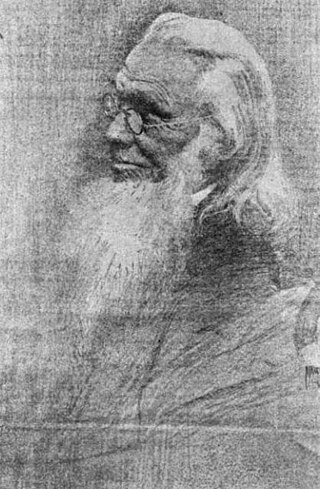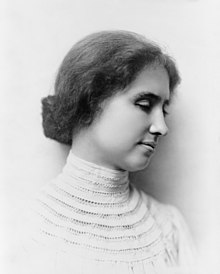
Tadoma is a method of communication utilized by deafblind individuals, in which the listener places their little finger on the speaker's lips and their fingers along the jawline. The middle three fingers often fall along the speaker's cheeks with the little finger picking up the vibrations of the speaker's throat. It is sometimes referred to as tactile lipreading, as the listener feels the movement of the lips, the vibrations of the vocal cords, expansion of the cheeks and the warm air produced by nasal phonemes such as 'N' and 'M'. Hand positioning can vary, and it is a sometimes also used by hard-of-hearing people to supplement their remaining hearing.
Perkins School for the Blind, in Watertown, Massachusetts, was founded in 1829 and is the oldest school for the blind in the United States. It has also been known as the Perkins Institution for the Blind.

A telecommunications relay service, also known as TRS, relay service, or IP-relay, or Web-based relay service, is an operator service that allows people who are deaf, hard of hearing, deafblind, or have a speech disorder to place calls to standard telephone users via a keyboard or assistive device. Originally, relay services were designed to be connected through a TDD, teletypewriter (TTY) or other assistive telephone device. Services gradually have expanded to include almost any real-time text capable technology such as a personal computer, laptop, mobile phone, PDA, and many other devices. The first TTY was invented by deaf scientist Robert Weitbrecht in 1964. The first relay service was established in 1974 by Converse Communications of Connecticut.

Usher syndrome, also known as Hallgren syndrome, Usher–Hallgren syndrome, retinitis pigmentosa–dysacusis syndrome or dystrophia retinae dysacusis syndrome, is a rare genetic disorder caused by a mutation in any one of at least 11 genes resulting in a combination of hearing loss and visual impairment. It is a major cause of deafblindness and is at present incurable.
Tactile signing is a common means of communication used by people with deafblindness. It is based on a sign language or another system of manual communication.
Sensory substitution is a change of the characteristics of one sensory modality into stimuli of another sensory modality.

Marie Heurtin was a French deafblind woman. Despite learning no language until the age of ten, Marie was taught to sign, read, and write by the nuns of Notre Dame de Larnay, a convent near Poitiers. As a young adult, Marie helped educate other deafblind girls at the convent, including her younger sister, who was also deafblind.

Na Laga'at is a nonprofit organization founded in 2002 by Adina Tal and Eran Gur around the first of its kind in the world ensemble whose actors are all deafblind. The organization established a unique cultural center at the Levantbondet House in the Port of Jaffa in Tel Aviv. The center is a platform for creative arts, which promote equal and open dialogue and lead to social change built on the belief in the human spirit and its ability to reach out and make a change.
Assistive Technology for the Deaf and Hard of Hearing is technology built to assist those who are deaf or suffer from hearing loss. Examples of such technology include hearing aids, video relay services, tactile devices, alerting devices and technology for supporting communication.

Haben Girma is an American disability rights advocate, and the first deafblind graduate of Harvard Law School.

Geraldine Jerrie Lawhorn was a figure of the American deafblind community, a performer, actress, pianist, then instructor at the Hadley Institute for the Blind and Visually Impaired. At 67 years old, she became the first deafblind African American to earn a college degree in the United States of America.

Haben: The Deafblind Woman Who Conquered Harvard Law is a memoir by Haben Girma, disability rights advocate and first deafblind graduate of Harvard Law School.

James Morrison Heady was an American deafblind author. Heady published multiple volumes of children's books and poetry and was frequently referred to by the contemporary press as the "Blind Bard of Kentucky". He was one of the first advocates for books for the blind in the United States and he invented several devices to facilitate communication and improve quality of life for deaf and blind people.
Deaf and hard of hearing individuals with additional disabilities are referred to as "Deaf Plus" or "Deaf+". Deaf children with one or more co-occurring disabilities could also be referred to as hearing loss plus additional disabilities or Deafness and Diversity (D.A.D.). About 40–50% of deaf children experience one or more additional disabilities, with learning disabilities, intellectual disabilities, autism spectrum disorder (ASD), and visual impairments being the four most concomitant disabilities. Approximately 7–8% of deaf children have a learning disability. Deaf plus individuals utilize various language modalities to best fit their communication needs.
Deafblind UK is a national charity in the United Kingdom supporting people with sight and hearing loss to live the lives they want. Founded in 1928, Deafblind UK has its headquarters in Peterborough, Cambridgeshire. The charity help people to live with deafblindness by making connections, and building their confidence and independence through a range of services and campaigns. Run by staff and volunteers, the current CEO is Steve Conway, who has been in position since 2018. The current chairman in Robert Nolan.
Anindya Bapin Bhattacharyya is an Indian American technology instructor for the deafblind. He coordinates the National Outreach Technology Development and Training Program at the Helen Keller National Center for DeafBlind Youths and Adults, traveling the country teaching deafblind people to use adaptive technology. Deaf from birth and blind at the age of nine, Bhattacharyya has been an advocate for deafblind individuals in the United States and beyond.
Gerrit van der Mey was a deafblind Dutch mathematician. He helped create software for PTERA and ZEBRA, some of the first computers designed in the Netherlands, as well as creating compilers for later computers. In 1982 he was made a member of the Order of Orange-Nassau at the grade of knight.
Protactile is a language used by deafblind people using tactile channels. Unlike other sign languages, which are heavily reliant on visual information, protactile is oriented towards touch and is practiced on the body. Protactile communication originated out of communications by DeafBlind people in Seattle in 2007 and incorporates signs from American Sign Language. Protactile is an emerging system of communication in the United States, with users relying on shared principles such as contact space, tactile imagery, and reciprocity.
Satoshi Fukushima is a Japanese researcher and advocate for people with disabilities. Blind since age nine and deaf from the age of eighteen, Fukushima was the first deafblind student to earn a degree from a Japanese university when he graduated from Tokyo Metropolitan University in 1987. Fukushima leads the Barrier-Free Laboratory, part of the Research Center for Advanced Science and Technology at the University of Tokyo; the research done by members of the lab's staff focuses on accessibility.









